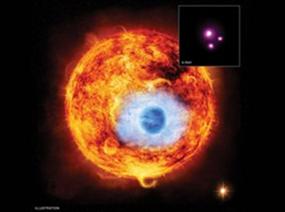 NASA’s Chandra Sees Eclipsing Planet in X-rays for First Time. This graphic depicts HD 189733b, the first exoplanet caught passing in front of its parent star
NASA’s Chandra Sees Eclipsing Planet in X-rays for First Time. This graphic depicts HD 189733b, the first exoplanet caught passing in front of its parent star
Image Credit: X-ray: NASA/CXC/SAO/K.Poppenhaeger
For the first time since exoplanets, or planets around stars other than the sun X-ray observations have detected an exoplanet passing in front of its parent star. An advantageous alignment of a planet and its parent star in the system HD 189733, which is 63 light-years from Earth, enabled NASA’s Chandra X-ray Observatory and the European Space Agency’s XMM Newton Observatory to observe a dip in X-ray intensity as the planet transited the star.
”Thousands of planet candidates have been seen to transit in only optical light,” said Katja Poppenhaeger of Harvard, who led a new study to be published in the Aug. 10 edition of The Astrophysical Journal. ”Finally being able to study one in X-rays is important because it reveals new information about the properties of an exoplanet.”
The planet, known as HD 189733b, is similar in size to Jupiter but has a very close orbit around its star of once every 2.2 days. HD 189733b has blue in color as a result of the preferential scattering of blue light by silicate particles in its atmosphere. ”The X-ray data suggest there are extended layers of the planet’s atmosphere that are transparent to optical light but opaque to X-rays.
Ultraviolet and X-ray radiation from the main star are evaporating the atmosphere of HD 189733b over time. ”The extended atmosphere of this planet makes it a bigger target for high-energy radiation from its star, so more evaporation occurs,” said co-author Scott Wolk.
The paper is available online at: http://arxiv.org/abs/1306.2311
Text: George A. Filer, New Jersey

 NewsVoice är en nättidning för oberoende nyheter, debatt och analys.
NewsVoice är en nättidning för oberoende nyheter, debatt och analys. 